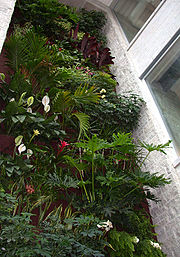Living wall

Second-order walls contain only plants and some insects, while third-order walls house fish and salamanders in a pool at the bottom of the wall, where the trickling water is captured before being filtered and recirculated to the top again.
'Active walls' are joined to a building's air circulation system. Fans blow air through the wall and then recirculate the air throughout the building. Some active walls are kept behind glass to create more predictable airflow effects. 'Inactive walls' have no mechanized air circulation. Instead, they are kept open to promote as much free air circulation as possible.
The living wall is a form of urban agriculture or urban gardening. It may be built as a work of art for its beauty. It is sometimes built indoors to help cure sick building syndrome or otherwise increase the oxygen levels in recirculated air.
It is also a means for water reuse, at least as utility water. The plants may purify slightly polluted water (such as greywater) by digesting the dissolved nutrients. Bacteria mineralise the organic components to make them available to the plants.
Living walls are particularly suitable for cities, as they allow good use of available vertical surface areas. They are also suitable in arid areas, as the circulating water on a vertical wall is less likely to evaporate than in horizontal gardens. In arid and hot areas, the living wall can be part of the external walls of a building, and can be used to refresh the latter.
See also
- Green roof
- Roof garden
- Hydroponics
- The Hanging Gardens of Babylon
- Musée du Quai Branly
- Biofiltration